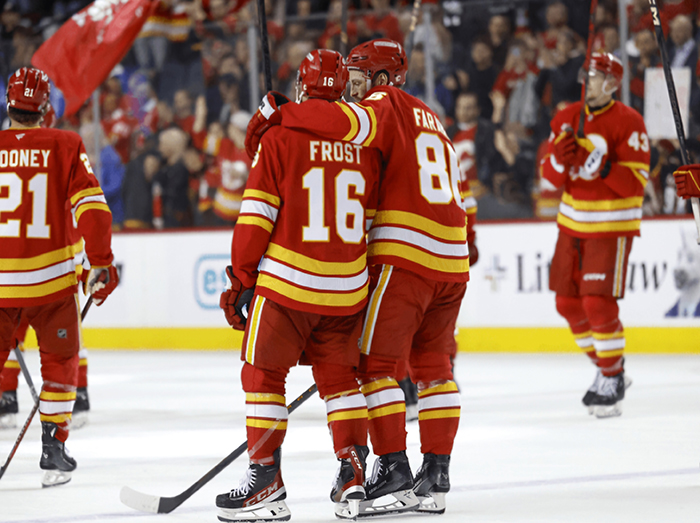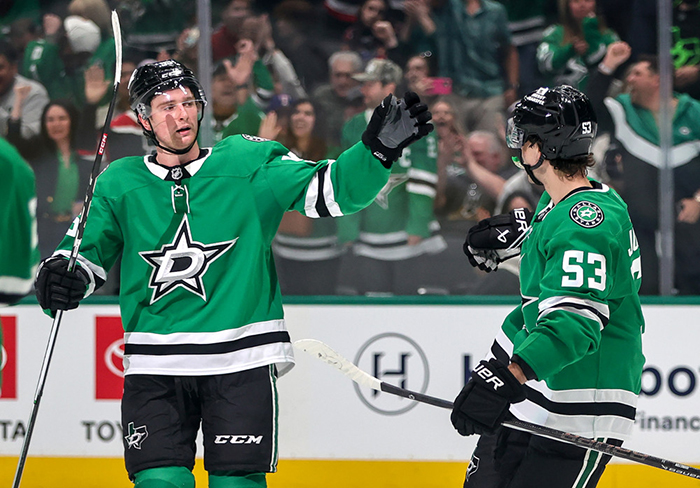Bill Meltzer’s Flyers blog on Hockey Hot Stove is brought to you by Phans of Philly, by Lights On Electric, by New Balance of Mount Laurel, and by Cover All Exteriors.

Saturday night was a glass half full/ half empty night for Rick Tocchet’s Philadelphia Flyers. The Carolina Hurricanes widely outplayed Philadelphia in the first and third periods. Nevertheless, Philly scored the only goals of the frames. Meanwhile, the second period was largely even but saw Carolina outscore Philly, 3-1.
The game went to sudden death overtime. The Flyers thought they won the game on Bobby Brink’s would-be second tally of the night. Unfortunately, the War Room in Toronto overturned the on-ice “legal goal” ruling. Play resumed. Subsequently, Carolina’s Seth Jarvis scored on a one-timer to end the game. The Flyers settled for one point from a 4-3 overtime defeat. Here’s the good, the bad, and the ugly from Saturday night’s game.
The Good
- The Cates line. The Tyson Foerster-Noah Cates-Bobby Brink link picked up where they left off last season. They’ve been Philadelphia’s best line in each of the first two games. Meanwhile, Brink in particular had one of his best career games on Saturday. The diminutive winger has always been known more for quickness than speed. However, on Saturday night, he looked downright fast. Brink is off to a great start after a strong training camp.
- Goalies have been good. Dan Vladar produced a strong effort in a losing cause on opening night. Samuel Ersson was arguably even better on Saturday. Don’t go by the four goals against or the .900 save percentage for the night. Ersson helped steal a point. Meanwhile, the team itself probably deserved zero points but also could have come away with two.
- Grebenkin’s solid debut. Nikita Grebenkin played well in his Flyers debut. Despite playing fourth-line minutes, the young Russian winger made an impact. He even collected his first NHL assist in unusual fashion. He kept a play alive along the board and headed off to complete a line change. By the time Brink scored a sniper’s goal for a 2-1 lead, Grebenkin was already seated on the bench. Nevertheless, he earned the secondary assist. In the third period, Tocchet rewarded Grebenkin with one left wing shift on the Cates/Brink line.
- Penalty kill. The Flyers won the special teams battle on Saturday. They killed off three first period penalties successfully. They also generated an Owen Tippett power play goal in the final minute of the frame. Carolina dominated 5-on-5 play (except when the Cates line was on the ice). But Philly had the better special teams performance, especially the PK. Consequently, the Flyers stole a point they probably didn’t deserve.
The Bad
- Need other lines to contribute more. The likes of Trevor Zegras, Travis Konecny and Tippett generated sporadic good plays in the first two games. That’s not enough, especially at 5-on-5. Meanwhile, Matvei Michkov has opened the new seasons with two clunkers by his standards. He’s trying to do what Tocchet has asked of him but, so far, it’s not clicking. On the bright side, it was good to see Michkov stick up for a teammate. His teammates emphatically killed the resulting third period penalty on his behalf. Things like that bring a club closer together.
- Overreliance on Sanheim. Right now, there’s not choice. The Flyers have to lean heavily on Travis Sanheim to play a ton of minutes (including large-scale D zone even strength and PK time). The blue line overall is a mess. No depth. Far-from-ideal pairings. Hold-your-breath shift from any iteration of the third pair. Meanwhile, the Flyers hope Cam York can return for the home opener on Monday.
- Too many early game penalties. It was a problem in Florida. It was a problem again in Raleigh. The wave of early game penalties in the first two matches were both a symptom and a cause of Philly’s issues. They spend too much time defending. A pair of discipline or communication lapse penalties stand out in particular. Zegras took one in Florida. Konecny had one against Carolina.
The Ugly
- OT goalie interference. First things first, the Toronto “situation room” made the right call. Even if a goalie initiates incidental contact with an attacker in the blue paint, the NHL Rule Book (Rule 69) instructs a no-goal ruling. The gray area is when a defending player pushes and attacker into the blue paint. Officials must then rule on whether the attacker made a reasonable effort to avoid the incidental contact. In this case, Sanheim was not pushed. As soon as it went to replay, the overturned OT goal was inevitable.
- Too many transition rushes allowed.The Flyers generally played a good second period. There was much more forecheck and flow for Philly. However, they got outscored 3-1. Ersson wasn’t to blame on any of the goals. Carolina had numbers on counterattacks. A goalie can only cover so much. Carolina thrives off transition plays.
- York won’t be enough. Cam York’s return would help stabilize the top two pairs. Nick Seeler can move down to play with Drysdale. York will rejoin Sanheim. Unfortunately, the third pair is still a major concern.




Hey, Bill. Are the Flyers wearing a jersey patch or helmet sticker to honor Bernie? If so, for how long. Bernie deserves a full year.
Yes. The jersey patch debuts tomorrow night, along with the big 1 behind rhe nets. It’s for the whole season.
Thanks. Nice gesture. I’d love to see them incorporate Mr. Snider’s signature into the uni. Inside collar? Something that keeps his legacy going.
Is it me or does MM look out of shape? He looks heavier and not in a good way?